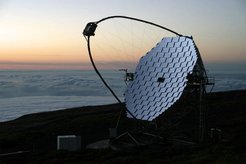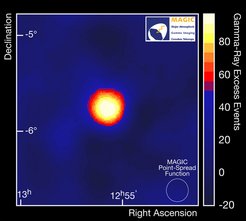High energy and far vision
With a 17-m diameter mirror the MAGIC telescope is the largest stand-alone gamma-ray telescope. MAGIC has discovered the most distant very-high energy gamma-ray emission.
Using the MAGIC (Major Atmospheric Gamma-ray Imaging Cherenkov) telescope on the Canary island of La Palma, scientists of the Max Planck Institute for Physics in Munich have succeeded in detecting very-high energy gamma rays from a source more than double as distant as any previously known gamma-ray source. Together with their colleagues of the MAGIC collaboration, the scientists discovered very high energy gamma rays from "3C 279", the active nucleus of a distant galaxy. 3C 279 is more than five billion light years away - roughly half the radius of the Universe. (Science June 27, 2008)

3C279 is a prominent member of the class of active galactic nuclei (AGNs) containing super-massive black holes, typically a billion times more massive than our own Sun, powered by accreting matter from surrounding stars or gas. AGNs emit radiation across the entire electromagnetic spectrum from radio wavelengths to very high energy (VHE) gamma-rays. Whereas most of the emission can travel through the Universe without being absorbed, the flux of VHE gamma rays is attenuated by pair-production in interactions with low energy photons of the extragalactic background light (EBL). The EBL comprises the history of all light produced by stars and galaxies in the Universe and is, therefore, of great interest as a record of cosmological structure formation. The detection of VHE gamma-ray emission from a source at such a distance as 3C279 constrains current theories about the density of the EBL. The Universe appears more transparent at cosmological distances than believed, precluding significant contributions from light other than from sources observed by current optical and infrared telescopes.
The MAGIC result confirms once more the rich potential of gamma-ray observations to open new avenues in astronomy. Gamma rays constitute the highest-energy electromagnetic radiation observable, and are generated by the most violent cosmic objects such as supernovae, active galactic nuclei, and gamma ray bursts. They allow us to zoom into a realm of extreme physical conditions, far beyond what can be studied in terrestrial laboratories. Gamma rays are of great importance as messengers in modern astroparticle physics and astronomy: they provide precious information about the processes that generated them, without deflections by magnetic fields that affect all charged cosmic rays. Since such particles travel for distances comparable with the radius of the Universe, they also give important information on fundamental physics and cosmology, in particular about the evolution of the Universe.

MAGIC is located at the Roque de los Muchachos Observatory, on the Canary island of La Palma. It detects gamma rays through short light flashes that are produced when gamma rays cross the atmosphere (Cherenkov light). A second MAGIC telescope (MAGIC-II) is under construction close to the first, and will be inaugurated in September 2008.
MAGIC-I was built and is operated by a large international collaboration, currently including about 150 researchers from Germany, Italy, Spain, Switzerland, Poland, Finland, Bulgaria and the United States.













